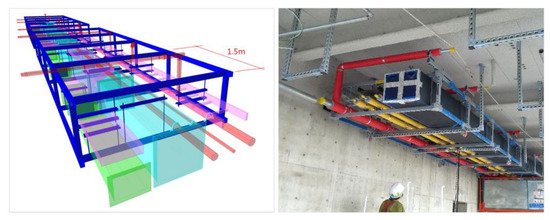The architecture, engineering, and construction (AEC) industry has witnessed significant advancements in technology over the years.
One of the most impactful changes has been the shift from traditional drafting tools like AutoCAD to Building Information Modeling (BIM) software like Revit.
While AutoCAD has been a trusted tool for decades, the growing demands for efficiency, collaboration, and precision are compelling AEC firms to embrace Revit.
Here are five compelling reasons why transitioning from AutoCAD to Revit can revolutionize your firm’s operations.
Table of Contents
Enhanced Collaboration Across Teams
A Unified Platform for Better Teamwork
AutoCAD, primarily a 2D drafting tool, often requires multiple files and external references (Xrefs) to manage a single project. This can lead to fragmented workflows, especially when multiple teams are working simultaneously.
Revit, on the other hand, offers a unified BIM environment where architects, engineers, and contractors can work collaboratively on a single model.
Key Benefits of Revit Collaboration:
Real-Time Updates: Changes made by one team are instantly visible to others, reducing the risk of miscommunication.
Centralized Data Management: A shared model ensures that everyone works with the most up-to-date information.
Seamless Integration: With cloud-based collaboration tools like Autodesk BIM 360, Revit enables teams to work together from anywhere in the world.
This integrated workflow fosters better communication, reduces errors, and ultimately leads to more efficient project delivery.
Improved Design Accuracy and Quality
Going Beyond Lines and Shapes
While AutoCAD excels at producing detailed 2D drawings, it relies heavily on the user’s ability to manage layers and alignments manually.
Revit, however, operates on an intelligent 3D modeling system where every element, from walls and windows to HVAC systems, is a data-rich component.
Advantages of Revit’s Precision:
Parametric Modeling: Revit elements are interconnected. For example, resizing a window will automatically adjust surrounding elements like walls and frames.
Clash Detection: Revit’s clash detection feature identifies conflicts between disciplines (e.g., a duct passing through a beam) early in the design phase.
High-Quality Visualizations: Revit’s 3D views and rendering capabilities provide realistic visuals, helping stakeholders better understand the design intent.
By minimizing human errors and improving design precision, Revit ensures that your projects meet higher quality standards.
Time and Cost Savings
Efficiency in Every Step
Time and budget overruns are common challenges in the AEC industry. Transitioning from AutoCAD to Revit can significantly mitigate these risks by streamlining workflows and automating repetitive tasks.
How Revit Saves Time and Money:
Automated Documentation: Revit automatically generates schedules, quantities, and construction documents, reducing manual effort.
Reuse of Data: With Revit, data from one phase of the project can be reused in subsequent phases, saving time during handovers.
Reduced Rework: Early detection of design conflicts and accurate documentation minimize costly rework during construction.
Studies show that firms using BIM tools like Revit report up to a 20% reduction in project timelines and significant cost savings, making it a smart investment for any AEC firm.
Futureproofing Your Firm
Staying Competitive in a Changing Industry
The AEC industry is rapidly moving towards BIM adoption as a standard. Governments and clients worldwide are increasingly mandating BIM deliverables for public and private projects. By sticking to AutoCAD, firms risk falling behind competitors who have already embraced BIM.
Benefits of Early Adoption:
Meeting Client Expectations: Many clients now demand BIM models for better project visualization and management.
Integration with Emerging Technologies: Revit’s compatibility with tools like virtual reality (VR), augmented reality (AR), and generative design ensures your firm stays ahead of the curve.
Sustainability: Revit’s energy analysis and simulation tools support sustainable design practices, which are becoming a priority in the industry.
Switching to Revit not only prepares your firm for current demands but also positions it to leverage future opportunities.
Streamlined Lifecycle Management
Beyond Design and Construction
AutoCAD is predominantly used for the design and drafting phase, while Revit’s BIM capabilities extend throughout the entire lifecycle of a project, from conceptual design to facility management.
Lifecycle Benefits of Revit:
Comprehensive Data: Revit models contain detailed information that can be used for maintenance and operations after construction is complete.
Digital Twins: Revit’s integration with digital twin platforms enables real-time monitoring and management of built assets.
Better Decision-Making: With all project data in one place, stakeholders can make informed decisions at every stage.
By offering value beyond construction, Revit helps firms build stronger, longer-lasting client relationships.
Making the Transition: Key Considerations
Switching from AutoCAD to Revit is a strategic decision that requires careful planning. Here are some steps to ensure a smooth transition:
1. Invest in Training
Equip your team with the necessary skills through comprehensive Revit training programs. Autodesk offers a range of resources, including tutorials and certifications.
2. Start with Pilot Projects
3. Leverage Support
Work with BIM consultants or Autodesk partners to guide your firm through the transition process and provide ongoing support.
4. Upgrade Hardware
Conclusion
The transition from AutoCAD to Revit is not just a change in software, it’s a transformation in how AEC firms approach design, collaboration, and project delivery. Revit’s advanced features, combined with its ability to streamline workflows and enhance collaboration, make it an indispensable tool for firms looking to stay competitive in today’s fast-paced industry.
By embracing Revit, your firm can deliver higher-quality projects, improve efficiency, and position itself as a leader in innovation.
The question is no longer whether you should make the switch, but when.
Contact us today to learn how our scalable and skilled Revit BIM Solutions transform your vision to reality.






